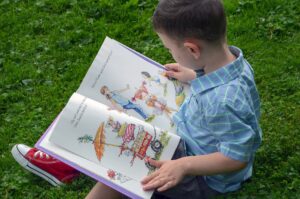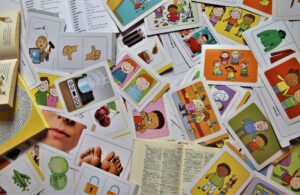Introduction Video
This video goes over the definition, language characteristics, causes, and prevalence of intellectual disability (ID).
Communication and Literacy Characteristics
Communication Characteristics
The majority of individuals with ID are able to develop functional communication skills, though they will often exhibit delays in reaching the milestones of communication development and have some specific difficulties within the different components of language.

Form:
- Individuals with ID will typically utilize simpler syntax & organization of language
Content:
- Concrete vocabulary is an area of relative strength
- Abstract concepts and figurative language are areas of relative difficulty
Use:
- Pragmatic skills, such as judging an appropriate level of familiarity in a given situation, are also an area of relative difficulty
Literacy Characteristics
With the proper support, most individuals with ID will learn how to read and write and will make progress in their literacy skills throughout elementary and secondary school. Thus, it is important to understand the characteristics of their literacy development.

Strengths:
- Orthographic processing, or the ability to recognize the correct and incorrect use of writing conventions, which includes word spellings
- Rapid automatized naming, or the ability to automatically label items on a page such as numbers, letters, objects, and colors
Weaknesses:
- Foundations of literacy, particularly phonological awareness and letter knowledge
- This has a domino-like effect on other areas of literacy development, such as
- vocabulary
- word decoding
- word recognition
- automaticity
- reading comprehension
- writing skills
- Because individuals with ID struggle with phonological awareness, this hampers the ability to decode unknown words. This then impacts their ability to read with automaticity, and if they are unable to read with automaticity, it is difficult for them to have a high level of reading comprehension.
Intervention Possibilities
Communication Interventions

Individuals with ID benefit most from communication interventions that take place in, or at least mirror, the contexts that occur in the child’s daily life, as this makes it easier for the child to generalize the skills learned in the interventions to their day-to-day lives.

Enhanced Milieu Teaching:
EMT is one example of an intervention occurring in relevant contexts that is intended to treat communication delays associated with ID. This intervention utilizes 6 main components.
- Environmental arrangement
- Responsiveness to the child’s communicative attempts
- Target-level language
- Expansion of the child’s communication
- Time delays
- Teaching prompts
- For a more complete overview of this intervention, see https://www.gadoe.org/Curriculum-Instruction-and-Assessment/Special-Education-Services/Documents/IDEAS%202015%20Handouts/2015%20Handouts/Enhanced%20Milieu%20Teaching.pdf
Literacy Interventions

Individuals with ID can benefit from intervention in complex reading areas, such as phonological awareness, and are not constrained to only learning word recognition without the ability to decode words.

Phonics Instruction:
Direct instruction of phonics through visual tools and games can help a child with ID better match phonemes to graphemes.
- Visual tools: physical letter manipulatives, tokens, etc.
- Games: identifying rhyming words, words that start with the same letter, etc.
Multicomponent Reading Interventions:
Instead of reading interventions that use one sole reading strategy, studies suggest that integrated reading strategies are widely beneficial. Additionally, multicomponent reading interventions work for nonverbal individuals with ID who use augmentative and alternative communication.
There are several multi-component reading interventions out there, but most include:
- A read-aloud strategy
- Direct instruction
- Prompting procedures
- Time-delay procedures
- Repeated trials
ACCESS:
Accommodations and assistive technologies, concrete topics, critical skills, explicit instruction, strategy instruction, and systematic evaluation (ACCESS) is a team of strategies for teachers to use when teaching individuals with ID writing skills. A more detailed review of each strategy follows.
- Accommodations and assistive technologies: includes anything from pencil grips to speech-to-text software to graphic organizers and can be chosen depending on the student’s needs
- Concrete topics: writing topics are concrete, not abstract, and include media such as pictures to further accomplish clarity
- Critical skills: helps the individual write about purposeful topics that can aid in life skills such as self-determination or even healthy eating habits
- Explicit instruction: teachers’ lessons are systematic, direct, and offer guidance and feedback
- Strategy instruction: emphasizes the need for a writing plan prior to the writing task and the adaptability of that plan while writing
- Systematic evaluation: ensures that individuals with ID are making progress in writing through task analysis tasks and teacher accountability
Bilingual Considerations for Children with Intellectual Disabilities

- Learning an additional language does not impede the overall language development of a child with ID!
- Bilingual children may exhibit delays in expressive language; this does not mean that they will not reach the same level of expressive language in time
- As with other bilingual children, the bilingualism of a child with ID should be viewed as a strength
- Because of the importance of communicating with one’s family and caregivers, the development of the child’s home language should be prioritized whenever possible
- Ideally, interventions such as EMT would be provided by a professional familiar with the language & culture of the student’s family
Resources
For an overview of ID:
American Association on Intellectual and Developmental Disabilities (AAIDD) – https://www.aaidd.org/
American Speech-Language-Hearing Association – www.asha.org/Practice-Portal/Clinical-Topics/Intellectual-Disability/
Special Olympics – https://www.specialolympics.org/about/intellectual-disabilities
Pictures From
References
Abbeduto, L., McDuffie, A. S., Thurman, A. J., & Kover, S. T. (2016). Language development in individuals with intellectual and developmental disabilities: From phenotypes to treatments. In R. M. Hodapp & D. J. Fidler (Eds.), International review of research in developmental disabilities: Vol. 50. International review of research in developmental disabilities: Fifty years of research in intellectual and developmental disabilities (p. 71–118). Elsevier Academic Press. https://doi.org/10.1016/bs.irrdd.2016.05.006
American Psychiatric Association. (2013). DSM-5 intellectual disability fact sheet. https://www.psychiatry.org/File%20Library/Psychiatrists/Practice/DSM/APA_DSM-5-Intellectual-Disability.pdf
ASHA. (n.d.). Intellectual disability. Retrieved November 8, 2020, from https://www.asha.org/Practice-Portal/Clinical-Topics/Intellectual-Disability/
Burgoyne, K., Duff, F. J., Nielsen, D., Ulicheva, A., & Snowling, M. J. (2016). Bilingualism and biliteracy in Down syndrome: Insights from a case study. Language Learning, 66(4), 945–971. https://doi.org/10.1111/lang.12179
Cannella-Malone, H. I., Konrad, M., & Pennington, R. C. (2015). ACCESS! Teaching writing skills to students with intellectual disability. TEACHING Exceptional Children, 47(5), 272–280. https://doi.org/10.1177/0040059915580032
Channell, M. M., Loveall, S. J., & Conners, F. A. (2013). Strengths and weaknesses in reading skills of youth with intellectual disabilities. Research in Developmental Disabilities, 34(2), 776–787. https://doi.org/10.1016/j.ridd.2012.10.010
De Valenzuela, J. S., Bird, E. K., Parkington, K., Mirenda, P., Cain, K., MacLeod, A. A., & Segers, E. (2016). Access to opportunities for bilingualism for individuals with developmental disabilities: Key informant interviews. Journal of Communication Disorders, 63, 32-46. http://dx.doi.org/10.1016/j.jcomdis.2016.05.005
Drysdale, H., van der Meer, L., & Kagohara, D. (2014). Children with autism spectrum disorder from bilingual families: a systematic review. Review Journal of Autism and Developmental Disorders, 2(1), 26–38. https://doi.org/10.1007/s40489-014-0032-7
Feltmate, K., & Kay-Raining Bird, E. (2008). Language learning in four bilingual children with Down syndrome: A detailed analysis of vocabulary and morphosyntax. Canadian Journal of Speech-Language Pathology and Audiology, 32(1), 6-20.
Harris, J. C. (2006). Developmental perspectives in psychiatry. Intellectual disability: Understanding its development, causes, classification, evaluation, and treatment. Oxford University Press.
Kaiser, A. P., & Hampton, L. H. (2017). Enhanced milieu teaching. In R.J. McCauley, M.E. Fey, R.B. Gillam, Treatment of language disorders in children (3rd ed., pp. 87–119). Brookes Publishing.
Kay-Raining Bird, E., Cleave, P., Trudeau, N., Thordardottir, E., Sutton, A., & Thorpe, A. (2005). The language abilities of bilingual children with Down syndrome. American Journal of Speech-Language Pathology, 14(3), 187–199. https://doi.org/10.1044/1058-0360
Keller, K., Troesch, L. M., & Grob, A. (2015). A large receptive–expressive gap in bilingual children. Frontiers in Psychology, 6. https://doi.org/10.3389/fpsyg.2015.01284
Levy, Y. (2011). IQ predicts word decoding skills in populations with intellectual disabilities. Research in Developmental Disabilities, 32(6), 2267–2277. https://doi.org/10.1016/j.ridd.2011.07.043
Lim, N., O’Reilly, M. F., Sigafoos, J., Ledbetter-Cho, K., & Lancioni, G. E. (2018). Should heritage languages be incorporated into interventions for bilingual individuals with neurodevelopmental disorders? A Systematic Review. Journal of Autism and Developmental Disorders, 49(3), 887–912. https://doi.org/10.1007/s10803-018-3790-8
National Center for Education Statistics. (2020, May). Students with disabilities. Retrieved September 20, 2020, from https://nces.ed.gov/programs/coe/indicator_cgg.asp
Pence Turnbull, K. L., & Justice, L. M. (2017). Language disorders in children. In Language development from theory to practice (3rd ed., pp. 290–317). Pearson Education, Inc.
Polišenská, K., Kapalková, S., & Novotková, M. (2018). Receptive language skills in Slovak-speaking children with intellectual disability: Understanding words, sentences, and stories. Journal of Speech, Language, and Hearing Research, 61(7), 1731-1742. http://doi.org/10.1044/2018_JSLHR-L-17-0029
Ratz, C., & Lenhard, W. (2013). Reading skills among students with intellectual disabilities. Research in Developmental Disabilities, 34(5), 1740–1748. https://doi.org/10.1016/j.ridd.2013.01.021
Sevcik, R. A., Barton-Hulsey, A., Walters, C., & Romski, M. (2019). Reading interventions for individuals with intellectual and developmental disabilities: A review. International Review of Research in Developmental Disabilities, 57, 81–118. https://doi.org/10.1016/bs.irrdd.2019.08.001
United States Department of Education. (n.d.). Our nation’s English learners. Retrieved September 20, 2020, from https://www2.ed.gov/datastory/el-characteristics/index.html
van Tilborg, A., Segers, E., van Balkom, H., & Verhoeven, L. (2014). Predictors of early literacy skills in children with intellectual disabilities: A clinical perspective. Research in Developmental Disabilities, 35(7), 1674–1685. https://doi.org/10.1016/j.ridd.2014.03.025
van Tilborg, A., Segers, E., van Balkom, H., & Verhoeven, L. (2018). Modeling individual variation in early literacy skills in kindergarten children with intellectual disabilities. Research in Developmental Disabilities, 72, 1–12. https://doi.org/10.1016/j.ridd.2017.10.017
Walczyk, J. J., Wei, M., Grifith-Ross, D. A., Goubert, S. E., Cooper, A. L., & Zha, P. (2007). Development of the interplay between automatic processes and cognitive resources in reading. Journal of Educational Psychology, 99(4), 867–887. https://doi.org/10.1037/0022-0663.99.4.867
Ware, J., Lye, C. B., & Kyffin, F. (2015). Bilingualism and students (learners) with intellectual disability: A review. Journal of Policy and Practice in Intellectual Disabilities, 12(3), 220–231. https://doi.org/10.1111/jppi.12124
Wehmeyer, M. L., & Shogren, K. A. (2016, October 14). Handbook of research-based practices for educating students with intellectual disability. Routledge & CRC Press. https://www.routledge.com/Handbook-of-Research-Based-Practices-for-Educating-Students-with-Intellectual/Wehmeyer-Shogren/p/book/9781315736198
Woll, B., & Grove, N. (1996). On language deficits and modality in children with Down syndrome: A case study of twins bilingual in BSL and English. The Journal of Deaf Studies and Deaf Education, 1(4), 271-278. https://doi.org/10.1093/oxfordjournals.deafed.a014302
Ypsilanti, A., Grouios, G., Alevriadou, A., & Tsapkini, K. (2005). Expressive and receptive vocabulary in children with Williams and Down syndromes. Journal of Intellectual Disability Research, 49(5), 353–364. https://doi.org/10.1111/j.1365-2788.2005.00654.x
